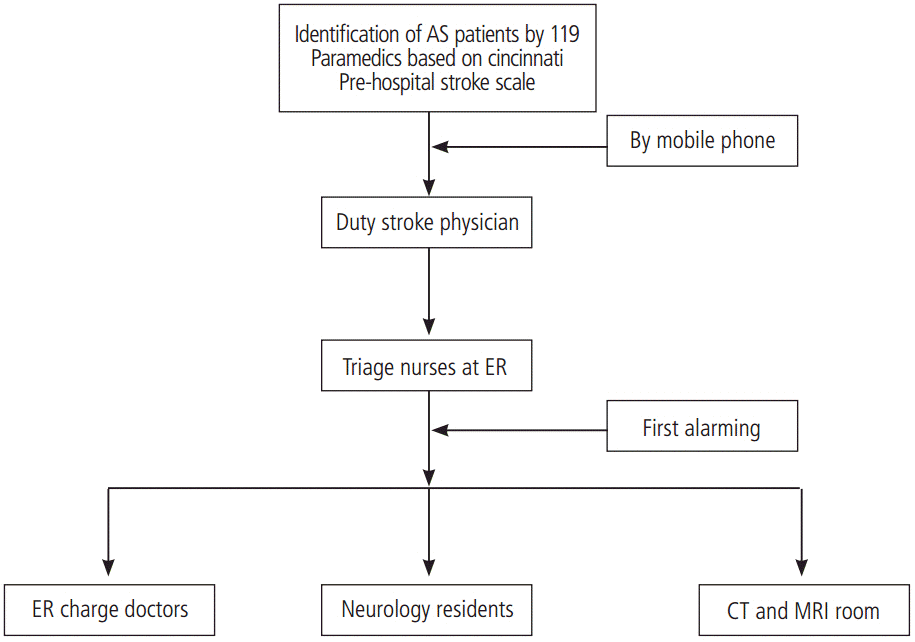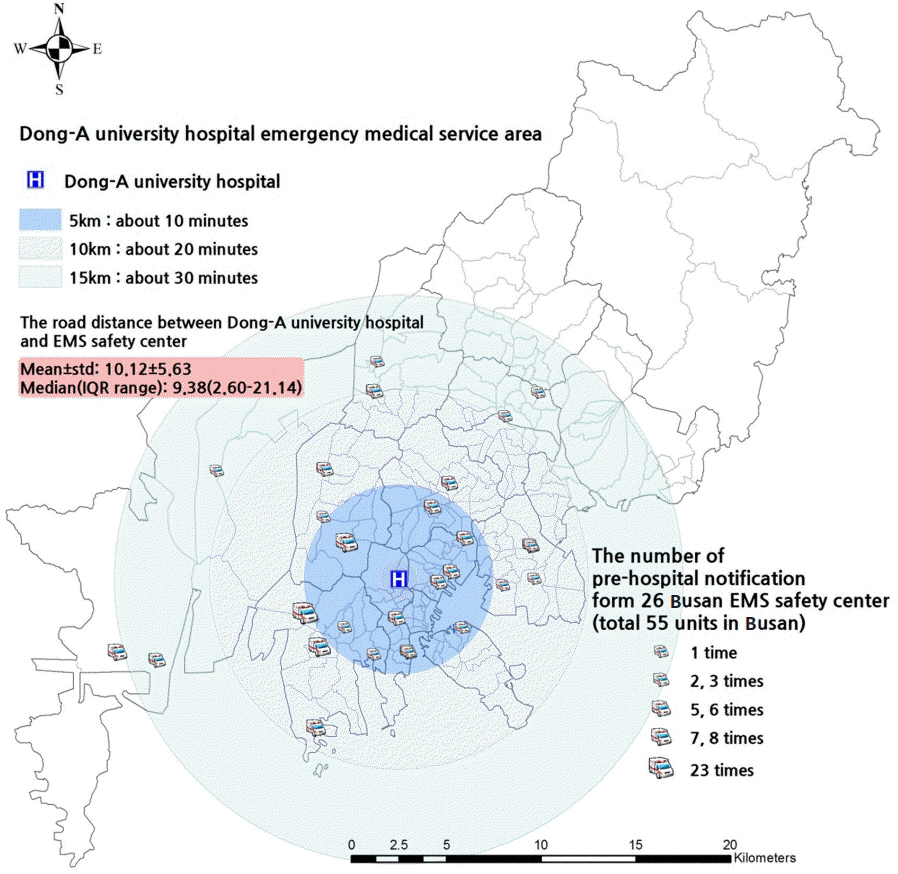INTRODUCTION
Despite the approval of thrombolytic therapy for the treatment of acute stroke (AS), the using rate of t-PA is still low [1-3]. To overcome this barrier, implementation of systemized stroke code can reduce delays in intra-hospital processing during acute stroke care [4,5]. Recently, several studies have shown that utilization of pre-hospital notification (PN) system by paramedics of emergency medical service (EMS) ambulances for patients with suspected AS may enhance the efficacy of stroke care [6]. Particularly, a PN system utilized by EMS allows hospitals to prepare and mobilize resources before the patient’s arrival. However, to implement this advanced system, the most important factor is to improve the accuracy of stroke detection in paramedics of the regional EMS [7].
In Korea, the Ministry of Health and Welfare (MHW) initiated the Regional Comprehensive Stroke Center (CSC) program to establish the efficient emergent care system for AS in 11 regional areas across South Korea. This government-initiated stroke care program rapidly improved the performance of acute stroke care in South Korea [8]. However, until now, there has not been any report to evaluate adopting the pre-hospital notification system of using direct calls from paramedics of the regional EMS in South Korea. The Busan-Ulsan regional CSC started a model project and determined the feasibility of its successful implementation. In this study, we investigated the accuracy of identifying acute stroke by 119 paramedics. Also, this study compared the door-to-imaging (DTI) time between suspected acute stroke patients with and without PN system.
METHODS
Our hospital is a 1,000 bed general teaching hospital located in Busan, a highly industrialized metropolitan area on the east coast of South Korea. Our hospital is a tertiary care facility with over 1,000 AS patients admitted through ERs each year. In February 2009, we established a CSC and implemented a stroke code activation system to enhance the performance of AS treatment. The CODE RED program is an automated activation system using a computerized physician order entry system, which expedites the activation of stroke team and thrombolytic treatment. Our door-to-imaging (DTI) time resulted in a mean time of 15.8±11.0 min for administration of t-PA to patients after implementation of CODE RED [9].
Our stroke center was designated as a Busan-Ulsan regional CSC by the MHW of South Korea in 2010.
Training paramedics to detect acute stroke patients
The Busan 119 EMS plays an important role in administering first aid and transporting emergency patients around the Busan metropolitan area. It consists of 55 safety centers with 341 paramedics dispersed throughout its territory.
To enhance the accuracy of the stroke detection rate in our region, we performed special education programs 21 times from July 2011 to July 2014. In this education program, we taught the Cincinnati Pre-hospital Stroke Screen to 341 paramedics in the Busan 119 EMS [10]. Additionally, we offered mobile phone numbers of all of our stroke team members to 119 ambulances to maintain a hot-line system between paramedics and our stroke center (Fig. 1).
Processing of suspected AS patients after prehospital notification from paramedics of the 119 EMS
Beginning in 2011, duty stroke specialists involved in the PN system were available to paramedics of 119 ambulances on a 24 hour basis. Whenever PN calls for suspected AS patients reached to our team members, we alerted our stroke system including ER members and prepared brain imaging facilities and beds at stroke units by activation of CODE RED (Fig. 1). In this study, we investigated the location and distance of transportation during PN. Additionally, we assessed the expected transfer time (GPS based transfer time from the EMS branch dispatching a suspected AS patient to our stroke center).
Study population and Data collection
In this study, to compare the accuracy of AS patient identification by paramedics of 119 ambulances using the PN to that of ER doctors, we recruited suspected AS patients who activated our stroke code, CODE RED, from Jan 2011 to July 2014. The stroke severity was assessed by the National Institutes of Health Stroke Scale (NIHSS), which was performed in the emergency room at the time of admission.
Statistical analysis
In this study, we compared the accuracy of AS detection and DTI times in suspected AS patients who participated in the paramedic pre-notification system and those who experienced activation of the CODE RED system by our ER doctors. All statistical analyses were performed using SAS 9.2. Categorical variables were summarized according to counts and relative frequencies, and numeric variables are shown as means ± standard deviation or median (interquartile range, IQR). Student’s t-test was used to analyze all continuous variables, and the Chi-squared or Fisher exact test was used for all categorical variables. The Wilcoxon rank-sum test was used to analyze data showing a nonparametric distribution.
RESULTS
During the observation period, paramedics of the Busan 119 EMS reported PNs for 91 suspected AS patients to our stroke team members via mobile phone. They were transported to our CSC from 28 Busan 119 EMS safety centers. The mean distance from the 28 safety centers giving PNs to our CSC was 10.1±5.6 km. The median distance was 9.4 (2.6-21.1) km. Almost all of these branches were located within 10 km of the CSC, which is approximately 20 min of transfer time by ambulance (Fig. 2).
Among the 91 patients with suspected AS reported by paramedics of the Busan 119 EMS, 57 patients (62.6%) were stroke patients (ischemic stroke, 33; hemorrhagic stroke, 19; and transient ischemic attack, 5 patients). Their median NIHSS score was 7.5 (3.0-13.5). Additionally, of those 91 patients, 58 cases initiated CODE RED because they were transferred to our ER within 8 hours of their initial symptoms.
In same period, 2,709 suspected AS cases activated CODE RED at ER. Among these cases, 1,578 patients (58.3%) were finally diagnosed with stroke (ischemic stroke, 937; hemorrhagic stroke, 399; and transient ischemic attack, 242 patients). Their median NIHSS score was 5 (1.0-13.0). The accuracy of stroke detection for patients diagnosed by paramedics was not significantly different from that for patients diagnosed by ER doctors (P=0.40). Although severity of strokes diagnosed by paramedics tended to be more intense than those diagnosed by ER doctors, there was no significant difference between the two groups. Also, there was no difference in distribution of each category (ischemic, hemorrhagic stroke, or transient ischemic attack) among patient with stroke (P=0.23).
Regarding the time interval from arrival to brain imaging, patients in the PN system had a mean DTI time of 13.4±8.1 min and a median time of 11 min. Meanwhile, patients that did not participate in this system had a mean DTI time of 32.7±252.8 min and a median time of 13 min. Pre-hospital notification from paramedics of the 119 EMS significantly shortened the mean DTI time compared to traditional care (P<0.01).
DISCUSSION
Before designation as a Busan-Ulsan regional CSC from our government, our stroke center had performed several studies regarding the feasibility of a PN system in our region. Our previous two reports [11,12]. showed its efficacy in shortening the intra-hospital processing time of AS patients. However, the previous two trials were conducted with patients referred from other community hospitals that were not able to properly care for AS patients. Therefore, there were no clinical benefits of the PN system due to the delay of care onset. Consequently, to create an efficient PN system for AS patients in our region, we need a direct call system between paramedics of the 119 EMS and our stroke team members.
In this study, paramedics reported only 91 suspected AS cases to our stroke team members via PN system. This was a very low number, considering that our AS facility treats over 1000 patients with AS admitted through the ER each year. This may have been caused a lack of political enforcement for PN by 119 EMS in South Korea. Additionally, until recently, many paramedics still did not sufficiently recognize the beneficial effects of the system. To solve these problems, we have provided all Busan 119 ambulance with mobile phone numbers of our stroke team members and shift information to encourage paramedics to use the pre-hospital notification system for suspected AS patients. We believe that this type of positive approach might be a good strategy to initiate a PN system for AS patients in the Busan region, which has no social system currently in place.
In our study, almost all patients were transported from 28 nearly located Busan EMS branches with an expected transfer time of 20 min. Therefore, paramedics of the Busan 119 EMS might have understood that the most important principle is that suspected AS patients should be rapidly transferred to the closest appropriate hospital [13].
Among the 91 patients diagnosed by paramedics, 62% of those were finally diagnosed with AS. Our educational programs for paramedics of the 119 EMS enhanced the detection rate by 17% compared to our previous results showing just 45% accuracy in the Busan metropolitan region [14]. The above finding suggested that our educational programs for the detection of AS might have been successful for paramedics in our region. However, western countries have shown an AS detection rate above 70% [15]; therefore, we need a more thorough approach to training paramedics in our region to enhance accuracy.
The most important beneficial effect of the PN system for AS patients was shortening the time to brain imaging [16]. This phenomenon was already confirmed in the Busan metropolitan region. In this study, we showed that PN of our stroke team members by paramedics of the 119 Busan EMS reduced mean DTI time by almost 20 min. Additionally, this system resulted in more consistent DTI times with less variation compared to cases where this system was not used. Particularly, our stroke center has achieved dramatic improvements in its processing time, resulting in duration of less than 30 min for door to needle time for IV thrombolysis in 2014 [9]. Therefore, there is no room for further improvement in intra-hospital processing time, and adopting this type of PN system is the only way to improve patient processing time.
Although some of our findings were significant, there were limitations to this study. This study was not designed in a prospective manner, and the sample size was inadequate to make definitive conclusions. However, due to this study, the PN system for AS patients could be successfully optimized in the Busan metropolitan region. Additionally, this study showed the possibility of expanding this system into 11 government-initiated CSCs across South Korea.




 PDF
PDF Citation
Citation Print
Print




 XML Download
XML Download